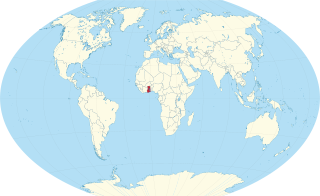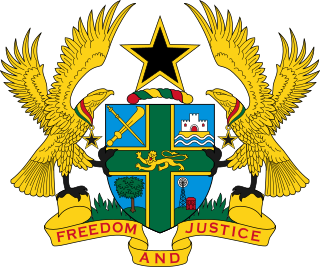
Ghana, officially the Republic of Ghana, is a country in West Africa. It abuts the Gulf of Guinea and the Atlantic Ocean to the south, sharing borders with Ivory Coast in the west, Burkina Faso in the north, and Togo in the east. Ghana covers an area of 239,567 km2 (92,497 sq mi), spanning diverse biomes that range from coastal savannas to tropical rainforests. With over 32 million inhabitants, Ghana is the second-most populous country in West Africa. The capital and largest city is Accra; other significant cities include Kumasi, Tamale, and Sekondi-Takoradi.

The area of the Republic of Ghana became known in Europe and Arabia as the Ghana Empire after the title of its Emperor, the Ghana. Geographically, the ancient Ghana Empire was approximately 500 miles (800 km) north and west of the modern state of Ghana, and controlled territories in the area of the Sénégal River and east towards the Niger rivers, in modern Senegal, Mauritania and Mali. The empire appears to have broken up following the 1076 conquest by the Almoravid General Abu-Bakr Ibn-Umar. A reduced kingdom continued to exist after Almoravid rule ended, and the kingdom was later incorporated into subsequent Sahelian empires, such as the Mali Empire. Around the same time, south of the Mali empire in present-day northern Ghana, the Kingdom of Dagbon emerged. The decentralised states ruled by the tindaamba were unified into a kingdom. Many sub-kingdoms would later arise from Dagbon including the Mossi Kingdoms of Burkina Faso and Bouna Kingdom of Ivory Coast. Dagbon pioneered Ghana's earliest learning institutions, including a university town, and a writing system prior to European arrival.
Yaa Asantewaa I was the Queen Mother of Ejisu in the Ashanti Empire, now part of modern-day Ghana. She was appointed by her brother Nana Akwasi Afrane Okese, the Edwesuhene, or ruler, of Edwesu. In 1900, she led the Ashanti war also known as the War of the Golden Stool, or the Yaa Asantewaa War of Independence, against the British Empire.

The Gold Coast was a British Crown colony on the Gulf of Guinea in West Africa from 1821 until its independence in 1957 as Ghana. The term Gold Coast is also often used to describe all of the four separate jurisdictions that were under the administration of the Governor of the Gold Coast. These were the Gold Coast itself, Ashanti, the Northern Territories protectorate and the British Togoland trust territory.

British Togoland, officially the Mandate Territory of Togoland and later officially the Trust Territory of Togoland, was a territory in West Africa under the administration of the United Kingdom, which subsequently entered a union with Ghana, part of which became its Volta Region. The territory was effectively formed in 1916 by the splitting of the German protectorate of Togoland into two territories, French Togoland and British Togoland, during the First World War. Initially, it was a League of Nations Class B mandate. In 1922, British Togoland was formally placed under British rule, and French Togoland, now Togo, was placed under French rule.

The national flag of Ghana consists of a horizontal triband of red, yellow, and green. It was designed in replacement of the British Gold Coast's Blue Ensign.

East Africa Protectorate was an area in the African Great Lakes occupying roughly the same area as present-day Kenya from the Indian Ocean inland to the border with Uganda in the west. Controlled by Britain in the late 19th century, it grew out of British commercial interests in the area in the 1880s and remained a protectorate until 1920 when it became the Colony of Kenya, save for an independent 16-kilometre-wide (10 mi) coastal strip that became the Kenya Protectorate.

The Anglo-Ashanti wars were a series of five conflicts that took place between 1824 and 1900 between the Ashanti Empire—in the Akan interior of the Gold Coast—and the British Empire and its African allies. The wars were mainly due to Ashanti attempts to maintain and enforce their imperial control over the coastal areas of present-day Ghana, where peoples such as the Fante and the Ga had come under the protection of the British. Although the Ashanti emerged victorious in some of these conflicts, the British ultimately prevailed in the fourth and fifth conflicts, resulting in the complete annexation of the Ashanti Empire by 1900.

The War of the Golden Stool, also known as the Yaa Asantewaa War, the Third Ashanti Expedition, the Ashanti Uprising, or variations thereof, was a campaign in 1900 during the series of conflicts between the United Kingdom and the Ashanti Empire, an autonomous state in West Africa that fractiously co-existed with the British and its vassal coastal tribes.
Ashanti Protectorate is alleged to have been established in 1902 from the Ashanti Confederacy, now Ashanti Region. There are multiple references to an "Ashanti Protectorate" in writings. However, so far no legal instrument has been identified that establishes this. This is because, in fact, the territory in question was established as a Crown Colony on 1 January 1902. A Crown Colony is not a Protectorate. They are two different things. After several prior wars with British troops, Ashanti was once again occupied by British troops in January 1896. In 1900 the Ashanti Uprising took place. The British suppressed the violence and captured the city of Kumasi. Ashanti's traditional king, the Asanthene, and his counselors were deported. The outcome was the annexation of Ashanti by the British so that it became part of His Majesty's dominions and a British Crown Colony with its administration undertaken by a Chief Commissioner under the authority of the Governor of the Gold Coast. Ashanti was classed as a colony by conquest. The legislation by which this annexation was effected and the administration constituted was the Ashanti Order in Council 1901 made on 26 September 1901.

The Gold Coast was the name for a region on the Gulf of Guinea in West Africa that was rich in gold, petroleum, sweet crude oil and natural gas. This former region is now known as the country Ghana.

This is a survey of the postage stamps and postal history of Ghana, known as the Gold Coast before independence.

Ghana was the first African country colonised by European powers to achieve independence under majority rule. During the first three years after independence, from 1957 to 1960, Ghana was a Commonwealth realm with a Westminster system of government and Elizabeth II, the British monarch, served as Queen of Ghana. Although the country was sometimes referred to as the Dominion of Ghana during this period, it never held the formal status of Dominion within the British Empire.

Ghanaian nationality law is regulated by the Constitution of Ghana, as amended; the Ghana Citizenship Act, and its revisions; and various international agreements to which the country is a signatory. These laws determine who is, or is eligible to be, a national of Ghana. The legal means to acquire nationality, formal legal membership in a nation, differ from the domestic relationship of rights and obligations between a national and the nation, known as citizenship. Nationality describes the relationship of an individual to the state under international law, whereas citizenship is the domestic relationship of an individual within the nation. Ghanaian nationality is typically obtained under the principle of jus sanguinis, born to parents with Ghanaian nationality. It can be granted to persons with an affiliation to the country, or to a permanent resident who has lived in the country for a given period of time through naturalization.
Sir James Henley Coussey was a jurist in Gold Coast. He was a Puisne Judge of the Supreme Court of the Gold Coast, 1944–52, and President of the West African Court of Appeal, 1955–58. He was conferred with a knighthood by King George VI on 8 June 1950.

The Ghana Independence Act 1957 is an Act of the Parliament of the United Kingdom that granted the Gold Coast fully responsible government within the British Commonwealth of Nations under the name of Ghana. The Act received royal assent on 7 February 1957 and Ghana came into being on 6 March 1957

The Northern Territories of the Gold Coast, commonly known as the Northern Territories, was a British protectorate in Africa from 1901 until 1957. The protectorate was administered by the Governor of the Gold Coast under a Chief Commissioner residing at Gambaga. A number of treaties were concluded in the name of Her Britannic Majesty with the Chiefs of Bona, Dagarti, Wa and Mamprusi at Gambaga. These treaties were made in 1896. Under the treaties, the Chiefs agreed not to conclude treaties with any other Power or to cede territory or to accept protectorates without the consent of Her Britannic Majesty. The Northern Territories were constituted as a district in 1897. The Northern Territories were formally established as a protectorate in 1901 under the Northern Territories Order in Council 1901 made on 26 September 1901. The Northern Territories remained a protectorate until the Ghana Independence Act 1957 annexed the Northern Territories by providing that the territories included immediately before 6 March 1957 in the Gold Coast should, as from that day, form part of Her Majesty's dominions by the name of Ghana.
The Gold Coast Artillery corps was formed in 1850.Their uniform was similar to that of the West India Regiments.

Ghana–United Kingdom relations are the diplomatic, historical and trade relations between Ghana and the United Kingdom. Modern state Ghana-UK relations began when Ghana became independent from the UK in 1957.














